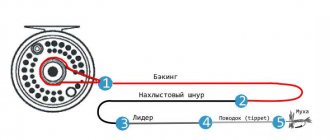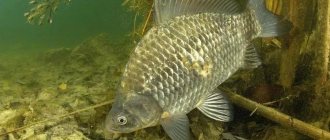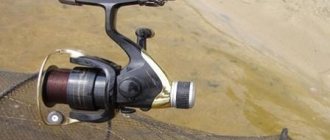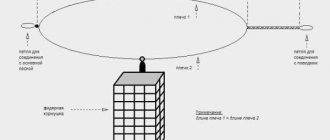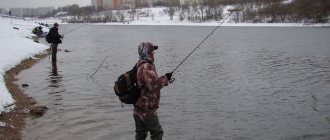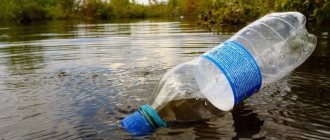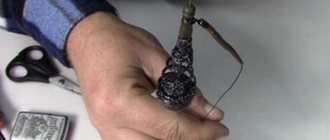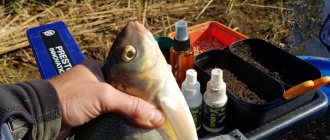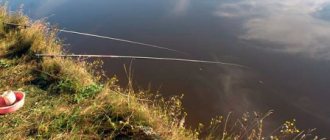Fly tying options
Tying a fly to a fishing line is done in various ways.
The simplest and most quickly remembered is the following Uni-knot (Fig. 1) or Duncan Loop: - take the main fishing line by its free end and thread it into the ring of the hook on which the fly is mounted;
— the section of cord formed behind the ring is placed parallel to the main line;
- form a loop from this segment, placing it below the general direction of the main line; in this case, the remaining free end is given a position in front of the main fishing line;
- use the free end to wrap the upper (double) part of the loop; do this 5...6 times; at least five times;
- holding the hook of the fly, pull the free tip; as a result, a knot is formed on the main line, at a short distance from the eye;
- then they work with the main fishing line - they pull on it; the previously formed nodule moves towards the ear and becomes denser;
- cut off, for example, with scissors, the excess fishing line - its protruding free end.
Siberian way
The difference between this method, used by fishermen when tying a fly, is that the hook must be positioned (!) with the tip up. The tying itself has two options and depends on the type of hook:
- a hook with a ring-shaped head of small diameter: tie it to the fishing line like this:
- thread a fishing line through the hole in the ring; do this from above, the free end of its segment will be located below;
- tie a knot on the last one, the size of which is larger than the size of the hole in the ring on the hook;
- cut off excess fishing line;
- for a hook with a large diameter ring on the head: the fishing line is attached to it, performing the following operations:
— from above, into the annular hole of the hook head, thread the fishing line;
- tie the hook with fishing line on the section of the fore-end below its head; any of the known and convenient nodes is suitable; this option is more durable and reliable.
Clinch Knot
The main advantage of such a unit (Fig. 2) is reliability. It is often used by foreign fishermen:
- take the hook by prying it with your fingers, placing the sting from below;
- thread the fishing line from bottom to top through the ring present on the head of the hook;
- pulling the main line, wrap it with a free segment of 5...6 r. one way;
- then the tip of the fishing line is passed through the loop at the head of the hook, which was formed when the previous operation was performed;
- pull the main cord; in this case, a knot is formed, which moves to the head of the hook and is fixed there;
- the last operation is to trim the end of the cord protruding from the formed knot.
Davy knot
This is a single knot (Fig. 3), which can easily be used to attach the fly to the monofilament line:
- thread the fishing line through the eye; they do it from top to bottom;
- form a loop from a free piece of cord, placing it below the main fishing line;
- insert the tip of a piece of cord into the loop created during the previous operation;
- wrap the lower branch of the loop with fishing line and insert the tip into it, leading out in the other direction;
- by pulling the main cord, a knot is formed; it “presses” against the hook itself;
- cut off the protruding excess fishing line.
Double Davy Knot
This is a more reliable version of a single knot (Fig. 4):
- as in a single knot, the first five positions are the same:
— the main line is wound into the ring from top to bottom;
- form a loop at the bottom of the main cord with the free tip in front of it;
- wrap the main fishing line with its free segment and put it into a loop;
- the following are the differences:
- make another turn of the fishing line around the main cord and bring it back inside the ring;
- pull the main cord; in this case, a nodule is formed near the ring;
- then trim off the excess.
Non-slip sea knot
This knot (Fig. 5) ensures free movement of the front sight relative to the fishing line:
- take the main cord, form a ring at its end section, with the tip of the cord wound into the last one;
- the resulting free segment is inserted from above into the eye on the hook; then they pass it through the loop that was previously made on the main cord;
- wrap the main line five times (no less) with its free section outside the loop and from the hook;
— the end of the free piece of cord is inserted into the loop formed at the very beginning (first operation);
- tighten the knot by pulling the main line;
- trim off the excess of the latter.
Triline node
This unit (Fig. 6) has increased reliability. It is started, unlike the others, by double passing the fishing line through the fastening ring provided on the hook; they pull it up, but not much.
Next, using a free piece, wrap it around 5...6 rubles. the main line in the direction from the hook. Afterwards it is threaded into a ring between two turns of fishing line (formed at the beginning). In the end, all that remains is to pull firmly on the main cord to tighten the knot.
Rapalova knot
The fastening unit (Fig. 7) for flies is offered by Rapala, which produces fishing products:
- first, form a loop from the fishing line with overlapping (wrapping) of the free tip;
- the cord is passed through the fastening ring on the hook;
- then it is pulled through the loop previously made in the first operation; tighten it, but slightly;
- wrap the main cord behind the loop with three turns of the free tip; he is also carried through the loop - the one resulting from the first operation; and again pulled through the loop (formed after the previous operation) above the main cord;
- Next you need to tighten the knot and trim off all the excess.
lovitut.ru
Fly knots for tying the fly, backing to the running line, backing to the reel, leader to the line.
One of the most common questions from beginning fly fishermen is the topic of fly fishing knots . But if you look thoroughly, there are not so many specific fly fishing knots. In the vast majority of cases, the knots that you successfully used “in a past life” when you successfully caught fish on a spinning rod, float or feeder will be sufficient Although these methods of fishing are radically different from fly fishing with an artificial fly, nevertheless, the fishing knots are largely the same.
In this article I want to cover several issues that are directly related to the topic of fly fishing knots. These are the questions we will consider
- Composition of modern fly fishing gear
- What knot to tie the backing to the fly reel?
- What knot connects the backing to the fly line?
- What is the best way to tie fly line and leader together?
- What fly knot should I use to tie my fly?
- Which knot is better to tie the streamer?
So, I begin, in order, to answer the questions posed by beginning fly fishermen . But first I would like to note that the issue of fly fishing knots is broader and more multifaceted than you imagine and what is described in this article. several solutions in stock for any fishing situation , so do not be surprised if someone uses a different knot for tying a fly than is described here. Also, do not look askance at those who do not use knots to connect the leader and fly line and the line itself with running and backing. And instead of nodes, it uses a loop-to-loop using connectors. fishing connector is a convenient and practical thing, more about it below. Let's move on to the answers that fly fishermen are waiting for!
Fly fishing gear
One of the most crucial moments is the choice of fly fishing gear. It consists of the following main elements:
- blank (rod)
- coil
- cord
- underbrush and bait
With this set of fishing accessories you can begin to get acquainted with fly fishing.
Additional details you will need later:
- floats and connectors
- carabiners and leashes
It is important to assemble such a fishing rod so that it is comfortable and obedient in the hands of a novice fisherman
Rod
Fly fishing rods or blanks are usually divided into classes.
As the class increases, the strength of the blank increases, and the rod is able to withstand greater loads. It is best to take your first steps in fly fishing with a 6-7 class fishing rod. Its strength is enough for both 200 gram grayling and 4 kilogram lenok.
Rods usually consist of 2 or 4 legs:
Two-piece models are more reliable because they have fewer connections, which reduces the number of breakdowns.
Four-piece fishing rods have the advantage of being longer. The form can be made from different materials:
- bamboo
- fiberglass
- carbon fiber
You can successfully fish with a rod made of any material, as long as it is not too flexible.
Particular attention must be paid to the handle. If the material used is leather or rubber, then it is better to refuse such a fishing rod
Only a cork handle is worthy of consideration for fly fishing.
Coil
Fly fishing reels are divided into three types:
- automatic
- cartoon
- ordinary
For a beginner fly fisherman, an ordinary model with an adjustable brake is suitable. The brake can be quiet or equipped with a ratchet
Read: Winter float rod
It is important that when the brake is in the tightened position, the cord does not come loose from the drum when tugging strongly on it. The weight of the reel should not exceed the weight of the rod
The reel drum should accommodate 30-60 m of 0.4 mm diameter extension line under the fly line. The optimal volume of fishing line will be such that the cord does not rub against the edges of the reel when wound.
Fly line
Along with the rod, fly line is the most expensive part of the tackle.
This is explained both by its special parameters and rapid wear even with careful use. During active fishing, you have to change the line twice during the season. The store may offer a sinking or floating option. With a floating model, it will be easier for a beginner to cast the equipment.
As for the class of the cord, it must correspond to the class of the fishing rod. Therefore, the optimal solution would be to purchase grade 6-7. Of all the colors, it is best to give preference to a white cord, which is most visible in the water.
After training on the shore or after fishing in dirty water, you should clean the cord with a special product, which is sometimes included in the box.
Leader or leash
A fishing line with a reducing diameter is used as a leader in fly fishing gear. For a beginner, the best option would be a taper of 0.5 mm to 0.2 mm. The thick end of the leash is tied to the cord, and the fly is mounted on the thin end of the fishing line.
The diameter of the undergrowth should be thinned as follows:
- 0.5 mm length 125 cm
- 0.45, 0.4, 0.35, 0.3 and 0.25 mm, 15 cm long
- 0.2 mm length 60 cm
The total length of the leash will be 2.6 m. If the length of the rod is less than this figure, then it is necessary to shorten the section with a thickness of 0.5 mm. In strong winds it is more convenient to use short undergrowth. Therefore, you should prepare several leashes of different lengths in advance.
It is imperative to check the condition of the fishing line on the leash after a series of casts for any knots. They reduce the strength of the fishing line, so such undergrowth must be replaced immediately.
Composition of modern fly fishing gear
Modern fly fishing gear consists of:
— A multi-part, collapsible fly fishing rod, necessarily equipped with guides, a reel seat and a cork handle.
— On the rod, in the reel seat, a modern, lightweight fly fishing reel is firmly fixed, necessarily equipped with a ratchet or friction brakes to prevent “running” and tangling of the cord.
- Before winding the fly line onto the reel, it is necessary to wind it and connect it with the Backing cord - an extending thin and strong cord or a special rigid fishing line, which saves in cases where a really large fish is caught, which easily pulls the fly line off the reel and continues to move
— A fly fishing line of various configurations is attached to the backing with a special knot or connection, which is also wound onto a reel. You shouldn’t wrap the cord very tightly, but there shouldn’t be any slack either.
— A conical leader (mono-leader, poly-leader) is attached to the front part of the fly line, which smoothly dampens the energy of the unfurling line and allows you to beautifully and carefully place the fly on the water (make a presentation).
— A leader made of monofilament line or fluorocarbon is attached to a conical fly leader, most often “loop-to-loop.” Sometimes fly fishermen say "hook material" - it's the same thing as a leader!
